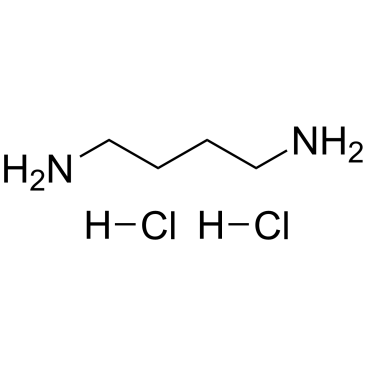butane-1,4-diaminium dichloride

butane-1,4-diaminium dichloride structure
|
Common Name | butane-1,4-diaminium dichloride | ||
|---|---|---|---|---|
| CAS Number | 333-93-7 | Molecular Weight | 161.073 | |
| Density | 1.472g/cm3 | Boiling Point | 159ºC at 760 mmHg | |
| Molecular Formula | C4H14Cl2N2 | Melting Point | 280 °C (dec.)(lit.) | |
| MSDS | Chinese USA | Flash Point | 51.7ºC | |
| Symbol |

GHS07 |
Signal Word | Warning | |
|
pH-triggered release of manganese from MnAu nanoparticles that enables cellular neuronal differentiation without cellular toxicity.
Biomaterials 55 , 33-43, (2015) At high concentrations, manganese (Mn) promotes cellular neurodevelopment but causes toxicity. Here, we report that Mn ion at high concentrations can be delivered to pheochromocytoma 12 (PC12) cells using gold nanoparticles (AuNPs) to enhance cellular neurode... |
|
|
Tritiation and characterization of several polyamine natural products.
Appl. Radiat. Isot. 98 , 71-3, (2015) Methods are presented to tritiate the polyamines putrescine and spermine. Copyright © 2015 Elsevier Ltd. All rights reserved. |
|
|
Effect of Novel Starter Culture on Reduction of Biogenic Amines, Quality Improvement, and Sensory Properties of Doenjang, a Traditional Korean Soybean Fermented Sauce Variety.
J. Food Sci. 80 , M1794-803, (2015) To select appropriate microorganisms as starter cultures for the reliable and reproducible fermentation of soybean fermented products of Korean Doenjang, various ratios of fungi (Aspergillus oryzae J, Mucor racemosus 15, M. racemosus 42) combined with Bacillu... |
|
|
HPLC-UV method validation for the identification and quantification of bioactive amines in commercial eggs.
Talanta 142 , 240-5, (2015) A quantitative and confirmatory high-performance liquid chromatography with ultraviolet detection (HPLC-UV) method for the determination of bioactive amines in the albumen and yolk of commercial eggs was developed, optimized and validated by analyte extractio... |
|
|
A novel approach for LC-MS/MS-based chiral metabolomics fingerprinting and chiral metabolomics extraction using a pair of enantiomers of chiral derivatization reagents.
Anal. Chim. Acta 898 , 73-84, (2015) Chiral metabolites are found in a wide variety of living organisms and some of them are understood to be physiologically active compounds and biomarkers. However, the overall analysis of chiral metabolomics is quite difficult due to the high number of metabol... |
|
|
Alteration of gut microbiota by vancomycin and bacitracin improves insulin resistance via glucagon-like peptide 1 in diet-induced obesity.
FASEB J. 29 , 2397-411, (2015) Firmicutes and Bacteroidetes, 2 major phyla of gut microbiota, are involved in lipid and bile acid metabolism to maintain systemic energy homeostasis in host. Recently, accumulating evidence has suggested that dietary changes promptly induce the alteration of... |
|
|
Peri-ovulatory putrescine supplementation reduces embryo resorption in older mice.
Hum. Reprod. 30 , 1867-75, (2015) Does peri-ovulatory putrescine supplementation of older mice improve oocyte quality and reduce the incidence of embryo resorption?Peri-ovulatory putrescine supplementation in older mice improved oocyte quality, as indicated by increased blastocyst cell number... |
|
|
Convergent functional genomics of oligodendrocyte differentiation identifies multiple autoinhibitory signaling circuits.
Mol. Cell. Endocrinol. 29 , 1538-53, (2009) Inadequate remyelination of brain white matter lesions has been associated with a failure of oligodendrocyte precursors to differentiate into mature, myelin-producing cells. In order to better understand which genes play a critical role in oligodendrocyte dif... |
|
|
Enteric neural progenitors are more efficient than brain-derived progenitors at generating neurons in the colon.
Am. J. Physiol. Gastrointest. Liver Physiol. 307(7) , G741-8, (2014) Gut motility disorders can result from an absent, damaged, or dysfunctional enteric nervous system (ENS). Cell therapy is an exciting prospect to treat these enteric neuropathies and restore gut motility. Previous studies have examined a variety of sources of... |
|
|
Germline modification using mouse spermatogonial stem cells.
Meth. Enzymol. 477 , 17-36, (2010) Spermatogonial stem cells (SSCs) in the testes are a new target for germline modification. With the development of an in vitro culture system and spermatogonial transplantation technique, SSCs can now be manipulated and used as an alternative to embryonic ste... |